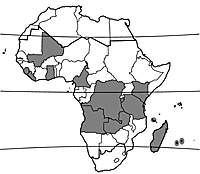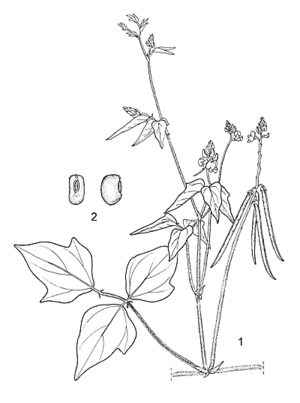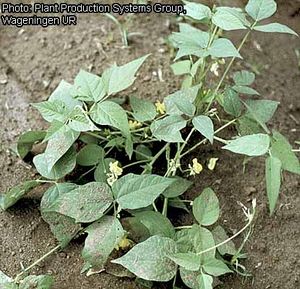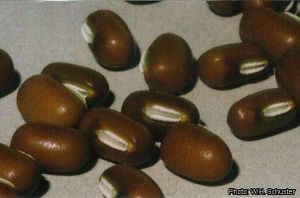Vigna umbellata (PROTA)
Introduction |
| General importance | |
| Geographic coverage Africa | |
| Geographic coverage World | |
| Cereal / pulse | |
| Vegetable | |
| Medicinal | |
| Forage / feed | |
| Auxiliary plant | |
| Food security | |
Vigna umbellata (Thunb.) Ohwi & Ohashi
- Protologue: Journ. Jap. Bot. 44(1): 31 (1969).
- Family: Papilionaceae (Leguminosae - Papilionoideae, Fabaceae)
- Chromosome number: 2n = 22
Synonyms
- Phaseolus calcaratus Roxb. (1832),
- Vigna calcarata (Roxb.) Kurz (1876).
Vernacular names
- Rice bean, red bean, climbing mountain bean (En).
- Haricot riz (Fr).
- Feijão arroz (Po).
Origin and geographic distribution
Rice bean originates from Asia, where it is found wild from India and central China through Indo-China to Malaysia. It was introduced by the Arabs into Egypt, along the eastern coast of Africa and to the Indian Ocean islands. Nowadays, rice bean is widely cultivated in tropical Asia, and to a more limited extent in Fiji, the United States, Australia, south-western Asia and tropical Africa and America. In tropical Africa it is grown in West Africa, East Africa and the Indian Ocean islands, and less frequently in Central and southern Africa.
Uses
Mature, dry rice bean seeds are eaten as a pulse. They are usually boiled and eaten with rice or instead of rice, often in soups or stews, e.g. in Ghana. In Madagascar flour of dried germinated rice bean seeds is included in complementary foods for children. Rice bean is not very popular in India, because it cannot easily be processed into dhal as it contains a fibrous mucilage, which prevents easy hulling and separation of the cotyledons.
The leaves, young pods and sprouted seeds of rice bean are eaten boiled as a vegetable. In India the young pods are sometimes eaten raw. The whole plant is used as fodder and made into hay and silage. The seeds are sometimes used as feed for livestock. Rice bean is also sown as a cover crop, green manure and living hedge.
Production and international trade
Rice bean production statistics are not available, but the crop is mainly produced in tropical Asia. Little of the rice bean production enters international trade. Japan is the main importer; the main exporters are Thailand, Myanmar and China. Madagascar also exports some rice bean; its average annual export in 1998–2000 has been estimated at 1100 t.
Properties
The composition of dried rice bean seeds per 100 g edible portion is: water 13.3 g, energy 1369 kJ (327 kcal), protein 20.9 g, fat 0.9 g, carbohydrate 60.7 g, fibre 4.8 g, Ca 200 mg, P 390 mg, Fe 10.9 mg, thiamin 0.49 mg, riboflavin 0.21 mg and niacin 2.4 mg (Leung, Busson & Jardin, 1968). The Ca content is high compared with other pulse crops, and rice bean is considered good for lactating mothers. Antinutritional factors in rice bean include trypsin-inhibiting factors, phytates, tannins and oligosaccharides. Soaking, sprouting, hulling and cooking can reduce these antinutritional factors considerably. Rice bean seeds do not contain cyanogenic glycosides. Protein concentrates prepared from rice bean seeds have shown in vivo anti-hypercholesterolaemic effects in hamsters. A peptide isolated from rice bean seeds has shown strong antifungal activity against Botrytis cinerea, Fusarium oxysporum, Rhizoctonia solani and Mycosphaerella arachidicola. Furthermore, it has shown mitogenic and anti-HIV-1 reverse transcriptase activity.
In the vegetative stage the rice bean plant (moisture content 84%) contains on a dry matter basis: 18.0% crude protein, 1.1% fat, 31.5% crude fibre, 39.9% N-free extract, 9.5% ash, 1.4% Ca and 0.35% P. In the flowering stage (moisture content 76%) it contains on a dry matter base: 14.5% crude protein, 1.0% fat, 32.1% crude fibre, 41.6% N-free extract, 10.8% ash, 1.2% Ca and 0.4% P. Its vigorous vegetative growth makes rice bean suitable for use as a cover crop and green manure.
Description
- Annual climbing herb, with stems up to 3 m long; stem grooved, usually clothed with fine, deciduous, deflexed hairs; taproot up to 1.5 m long.
- Leaves alternate, trifoliolate; stipules lanceolate, c. 1.5 cm long; petiole 5–10 cm long; stipels linear-lanceolate, c. 0.5 cm long; leaflets broadly ovate to ovate-lanceolate, 5–10(–13) cm × 1.5–6(–7) cm, entire or 2–3-lobed, the lateral leaflets unequal-sided, membranous, almost glabrous.
- Inflorescence an erect axillary false raceme, 3–10 cm long, 5–20-flowered, with flowers usually in pairs; peduncle up to 20 cm long.
- Flowers bisexual, papilionaceous; pedicel c. 5 mm long; calyx campanulate, c. 4 mm long, 5-toothed; corolla bright yellow, standard 1.5–2 cm in diameter; wings large and broad, enclosing the keel; keel with a curved beak and a conical pocket on one side; stamens 10, 9 connate into a tube, upper one free; ovary superior, 1-celled, style broadened and curved.
- Fruit a linear-cylindrical pod, 6–13 cm × 0.3–0.6 cm, deflexed, glabrous, green when young, black-brown at maturity, 6–8(–16)-seeded.
- Seeds oblong, 5–10 mm × 2–5 mm × 3–4 mm, smooth, yellow, green, dark red, brown, black, speckled or mottled; hilum excentric, elongate, hidden by a cream-coloured rim.
- Seedling with hypogeal germination.
Other botanical information
Vigna comprises about 80 species and occurs throughout the tropics. However, the tropical American species are likely to be placed in a separate genus in the near future, which would reduce the genus to 50–60 species. Vigna umbellata forms part of the subgenus Ceratotropis, which also includes Vigna radiata (L.) R.Wilczek (mung bean), Vigna mungo (L.) Hepper (black gram), Vigna angularis (Willd.) Ohwi & H.Ohashi (adzuki bean) and Vigna aconitifolia (Jacq.) Maréchal (moth bean). Vigna umbellata is closely related to Vigna angularis, with which it can be crossed using embryo culture and with rice bean as the female parent. Vigna minima (Roxb.) Ohwi & H.Ohashi, a wild species from tropical Asia, is even more closely related to Vigna umbellata.
Within Vigna umbellata 2 types have been distinguished, commonly designated as varieties:
- var. gracilis (Prain) Maréchal, Mascherpa & Stainier, the wild type with slender branchlets, narrow leaflets and long peduncles, found from India to Malaysia, the Philippines and central China. This taxon closely resembles Vigna minima, or should even be united with it.
- var. umbellata, the cultivated types.
Cultivars have mainly been identified on the basis of maturity period and seed colour. In Madagascar 2 types are distinguished: yellow rice bean (‘tsiasisa mavo’) and red rice bean (‘tsiasisa mena’).
Growth and development
Rice bean seedlings grow vigorously and establish themselves quickly. In Madagascar time to flowering is 70–75 days, time to seed maturity 100–135 days. In Angola the time from sowing to maturity can be as short as 60 days. In the Philippines time to flowering averages 64 days, to maturity 92 days; in India early-maturing types behave likewise, whereas late types ripen in 130–150 days. Flowers are self-compatible, but cross-pollination also occurs.
Ecology
Rice bean is typically suited to humid tropical lowlands, but some cultivars are adapted to subtropical or temperate conditions. It is found in areas with average temperatures of 18–30°C. It is susceptible to frost. In the tropics the crop can be grown up to 2000 m altitude. In Madagascar it is grown up to 1000 m altitude. Rice bean prefers a rainfall of 1000–1500 mm/year; it tolerates moderate drought. It is a quantitative short-day plant. Rice bean can be grown on a wide range of soil types, but grows best on fertile loams. The optimum pH is 6.8–7.5. Wild rice bean types are found in open locations and on roadsides.
Propagation and planting
Rice bean is propagated by seed. The 1000-seed weight varies widely, from 30–120(–230) g. Rice bean is usually broadcast, after 2–3 ploughings, at a seed rate of 70–90 kg/ha. It is also sown in rows 30–90 cm apart, at a seed rate of 20–70 kg/ha. A normal seed rate in India is 40–50 kg/ha if grown for seed or 60–70 kg/ha if grown as a catch crop for fodder. In India rice bean is normally a ‘kharif’ crop, sown in June–July and harvested in October–November. In Asia rice bean is mostly grown as an intercrop, especially of maize.
Management
Rice bean usually receives little care. Seedlings are able to smother weeds due to their vigorous growth. Fertilizers are seldom applied to a rice bean crop, although in India superphosphate at a rate of 17–26 kg P per ha is recommended. In Asia rice bean was formerly widely planted after the harvest of the traditional long-season rice crop (hence the name ‘rice bean’), but multiple cropping of short-duration rice cultivars has led to a decline of this practice.
Diseases and pests
Rice bean is seldom seriously affected by diseases and pests, but it is susceptible to root-knot nematodes (Meloidogyne spp.). Rice bean seeds are considered resistant to storage pests such as the bruchids Callosobruchus analis, Callosobruchus chinensis and Callosobruchus maculatus, due to the presence of compounds in the cotyledons with growth-inhibiting effects on them.
Harvesting
The viny habit and the shattering of pods make rice bean difficult to harvest. Harvesting of mature seeds, green pods and leaves is usually by hand. If grown for fodder, rice bean should be harvested when the pods are immature, since the leaves drop easily when the plant reaches maturity. As a green manure, rice bean can already be ploughed at about 30 days after sowing.
Yield
The average seed yield of rice bean is only 200–300 kg/ha, but the low yields are related to the often very short crop cycle. Experimental yields up to 2500 kg/ha have been obtained in India. Fresh fodder yields of 35 t/ha have been obtained.
Handling after harvest
Rice bean seeds are normally dried in the sun and threshed by hand. The seed stores well.
Genetic resources
Large germplasm collections of rice bean are kept in China (Institute of Crop Germplasm Resources (CAAS), Beijing; 1363 accessions) and India (National Bureau of Plant Genetic Resources (NBPGR), New Delhi; 902 accessions). No germplasm collections of rice bean are known in Africa. Rice bean is not threatened with genetic erosion, but more germplasm collection and characterization work are required.
Breeding
Breeding programmes of rice bean have been established mainly in India, where several improved cultivars have been developed and released. In tropical Africa no rice bean breeding programmes are known to exist.
Prospects
Rice bean is a valuable crop that deserves more testing throughout the tropics, because of its tolerance of high temperature and humidity, short crop cycle, resistance to diseases and pests, nutritious seeds and multiple uses. Limitations of rice bean production are low yields and easy shattering of the pods, which make harvesting difficult. Limited availability of germplasm and the lack of technical information on its cultivation are serious bottlenecks. The possibilities of industrial processing of the seeds into derived products, such as flour, are still poorly known. Research priorities for rice bean include the development of quick-maturing, day-neutral, high-yielding and non-shattering, erect cultivars that are nematode-resistant. Moreover, investigations are needed on agronomical aspects (e.g. time of sowing, plant density and fertilizer requirements) and post-harvest technology.
Major references
- Arora, R.K., Chandel, K.P.S., Joshi, B.S. & Pant, K.C., 1980. Rice bean: tribal pulse of eastern India. Economic Botany 34(3): 260–263.
- Burkill, H.M., 1995. The useful plants of West Tropical Africa. 2nd Edition. Volume 3, Families J–L. Royal Botanic Gardens, Kew, Richmond, United Kingdom. 857 pp.
- du Puy, D.J., Labat, J.N., Rabevohitra, R., Villiers, J.-F., Bosser, J. & Moat, J., 2002. The Leguminosae of Madagascar. Royal Botanic Gardens, Kew, Richmond, United Kingdom. 750 pp.
- Goel, S., Raina, S.N. & Ogihara, Y., 2002. Molecular evolution and phylogenetic implications of internal transcribed spacer sequences of nuclear ribosomal DNA in the Phaseolus-Vigna complex. Molecular Phylogenetics and Evolution 22(1): 1–19.
- Kashiwaba, K., Tomooka, N., Kaga, A., Han, O.-K. & Vaughan, D.A., 2003. Characterization of resistance to three bruchid species (Callosobruchus spp., Coleoptera, Bruchidae) in cultivated rice bean (Vigna umbellata). Journal of Economic Entomology 96(1): 201–213.
- Kay, D.E., 1979. Food legumes. Crops and Product Digest No 3. Tropical Products Institute, London, United Kingdom. 435 pp.
- Lawn, R.J., 1995. The Asiatic Vigna species. In: Smartt, J. & Simmonds, N.W. (Editors). Evolution of crop plants. 2nd Edition. Longman, London, United Kingdom. pp. 321–326.
- Maréchal, R., Mascherpa, J.-M. & Stainier, F., 1978. Etude taxonomique d’un groupe complexe d’espèces des genres Phaseolus et Vigna (Papilionaceae) sur la base de données morphologiques et polliniques, traitées par l’analyse informatique. Boissiera 28: 1–273.
- National Academy of Sciences, 1979. Tropical legumes: resources for the future. National Academy of Sciences, Washington, D.C., United States. 331 pp.
- van Oers, C.C.C.M., 1989. Vigna umbellata (Thunb.) Ohwi & Ohashi. In: van der Maesen, L.J.G. & Somaatmadja, S. (Editors). Plant Resources of South-East Asia No 1. Pulses. Pudoc, Wageningen, Netherlands. pp. 75–77.
Other references
- Chau, C.-F., Cheung, P.C.K. & Wong, Y.-S., 1998. Hypocholesterolemic effects of protein concentrates from three indigenous legume seeds. Journal of Agricultural and Food Chemistry 46(9): 3698–3701.
- CSIR, 1976. The wealth of India. A dictionary of Indian raw materials & industrial products. Raw materials. Volume 10: Sp–W. Publications and Information Directorate, Council of Scientific and Industrial Research, New Delhi, India. 591 pp.
- Das, N.D. & Dana, S., 1987. Natural outcrossing in rice bean. Plant Breeding 98: 68–71.
- Ellis, R.H., Lawn, R.J., Summerfield, R.J., Qi, A., Roberts, E.H., Chay, P.M., Brouwer, J.B., Rose, J.L., Yeates, S.J. & Sandover, S., 1994. Towards the reliable prediction of time to flowering in six annual crops. IV. Cultivated and wild mung bean. Experimental Agriculture 30(1): 31–43.
- FAO, 1989. Utilization of tropical foods: tropical beans. Compendium on technological and nutritional aspects of processing and utilization of tropical foods, both animal and plant, for purposes of training and field reference. FAO Food and Nutrition paper 47/4. FAO, Rome, Italy. 74 pp.
- FAO, 1998. The state of the world’s plant genetic resources for food and agriculture. FAO, Rome, Italy. 510 pp.
- Gopinathan, M.C., Babu, C.R. & Shivanna, K.R., 1986. Interspecific hybridization between rice bean (Vigna umbellata) and its wild relative (Vigna minima): fertility–sterility relationships. Euphytica 35(3): 1017–1022.
- Hanelt, P. & Institute of Plant Genetics and Crop Plant Research (Editors), 2001. Mansfeld’s encyclopedia of agricultural and horticultural crops (except ornamentals). 1st English edition. Springer Verlag, Berlin, Germany. 3645 pp.
- ILDIS, 2002. World database of Legumes, Version 6,05. International Legume Database & Information Service. [Internet] http://www.ildis.org/. November 2004.
- Kaga, A., Tomooka, N., Egawa, Y., Hosaka, K. & Kamijima, O., 1996. Species relationships in the subgenus Ceratotropis (genus Vigna) as revealed by RAPD analysis. Euphytica 88: 17–24.
- Khanda, C.M., Mohapatra, A.K. & Misra, P.K., 2001. Response of rice bean (Vigna umbellata) to row spacing and phosphorus under rainfed condition. Annals of Agricultural Research 22(4): 481–484.
- Leung, W.-T.W., Busson, F. & Jardin, C., 1968. Food composition table for use in Africa. FAO, Rome, Italy. 306 pp.
- Polhill, R.M., 1990. Légumineuses. In: Bosser, J., Cadet, T., Guého, J. & Marais, W. (Editors). Flore des Mascareignes. Famille 80. The Sugar Industry Research Institute, Mauritius, l’Office de la Recherche Scientifique Outre-Mer, Paris, France & Royal Botanic Gardens, Kew, Richmond, United Kingdom. 235 pp.
- Rabenarivo, C., 1992. Production et marché du haricot sec. United States Agency for International Development (USAID) / Madagascar Agricultural Export Liberalization Support Project (MAELSP), Antananarivo, Madagascar. 47 pp.
- Ralison, C., Ahimana, C., Arnaud, L. & Trèche, S., 2004. Amélioration de l’alimentation infantile en zone rurale: l’expérience du programme Nutrimad à Madagascar. In: Brouwer, I.D., Traoré, A.S. & Trèche, S. (Editors). Food-based approaches for a healthy nutrition in West Africa: the role of food technologists and nutrionists. Proceedings of the 2nd international workshop, Ouagadougou, Burkina Faso, 23–28 November 2003. Université de Ouagadougou, Burkina Faso / IRD, Montpellier, France / WUR, Wageningen, Netherlands / FAO, Rome, Italy. pp. 503–515.
- Saharan, K., Khetarpaul, N. & Bishnoi, S., 2002. Antinutrients and protein digestibility of fababean and ricebean as affected by soaking, dehulling and germination. Journal of Food Science and Technology 39(4): 418–422.
- Saikia, P., Sarkar, C.R. & Borua, I., 1999. Chemical composition, antinutritional factors and effect of cooking on nutritional quality of rice bean (Vigna umbellata (Thunb.) Ohwi and Ohashi). Food Chemistry 67(4): 347–352.
- Schuster, W.H., Alkämper, J., Marquard, R., Stählin, A. & Stählin, L., 1998. Leguminosen zur Kornnutzung (Kornleguminosen der Welt). Giessener Beiträge zur Enwicklungsforschung. Reihe 2 (Monographien), Band 11. Förderverein Tropeninstitut Giessen, Giessen, Germany. CD-ROM.
- Tindall, H.D., 1983. Vegetables in the tropics. Macmillan Press, London, United Kingdom. 533 pp.
- Ye, X.Y. & Ng, T.B., 2002. A new antifungal peptide from rice beans. Journal of Peptide Research 60(2): 81–87.
Sources of illustration
- van Oers, C.C.C.M., 1989. Vigna umbellata (Thunb.) Ohwi & Ohashi. In: van der Maesen, L.J.G. & Somaatmadja, S. (Editors). Plant Resources of South-East Asia No 1. Pulses. Pudoc, Wageningen, Netherlands. pp. 75–77.
Author(s)
- R. Rajerison, CNRE, B.P. 1739, Fiadanana, Antananarivo (101), Madagascar
Correct citation of this article
Rajerison, R., 2006. Vigna umbellata (Thunb.) Ohwi & H.Ohashi. In: Brink, M. & Belay, G. (Editors). PROTA (Plant Resources of Tropical Africa / Ressources végétales de l’Afrique tropicale), Wageningen, Netherlands. Accessed 18 December 2024.
- See the Prota4U database.







